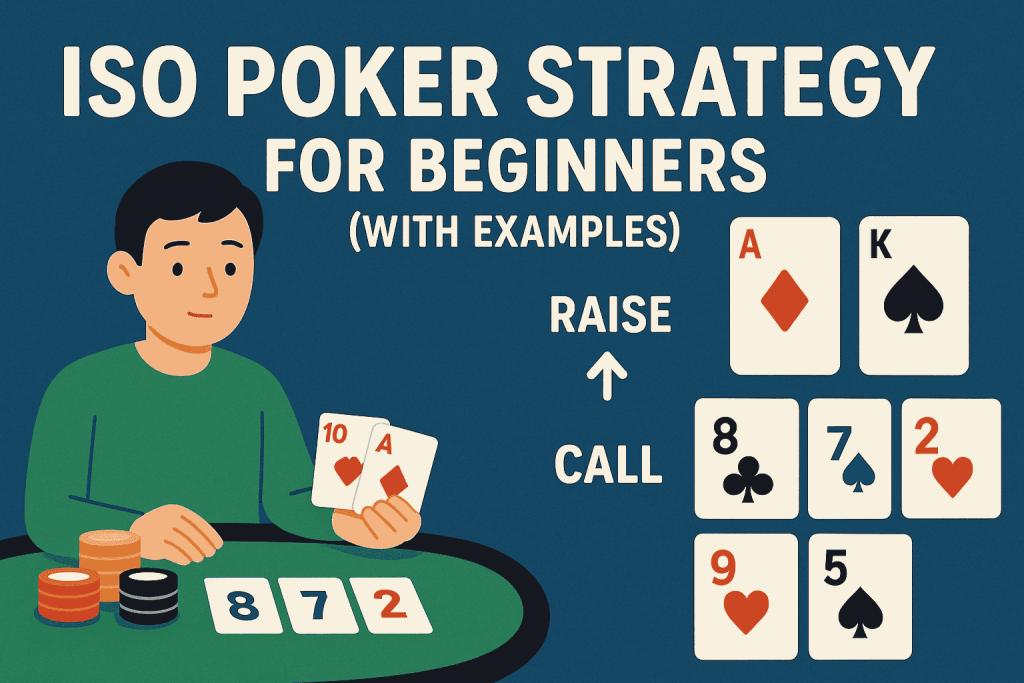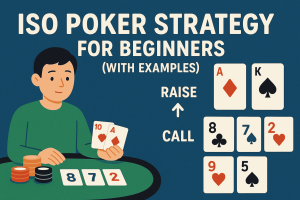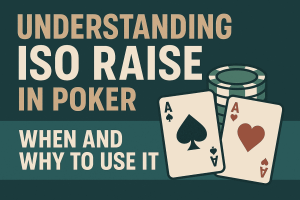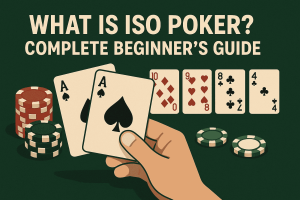The world of poker is filled with strategies designed to give players an edge, and one of the most effective yet often overlooked is the ISO raise. In the context of the iso poker game, ISO is short for “isolation,” and the concept behind it is simple: raise after a limp to isolate a single player, often a weaker one, and take control of the hand.
This strategy is especially important in modern games, where aggressive play is rewarded and passive limping is typically seen as a leak. By understanding and applying iso poker strategy correctly, beginners can immediately improve their win rate and decision-making at the table.
What Is ISO Poker Strategy?
The iso poker strategy revolves around the idea of isolating a limper—a player who enters the pot by calling the big blind without raising. Instead of limping behind or simply folding, a savvy player will raise with the goal of forcing other players to fold and going heads-up against the limper.
This strategic move allows you to play a simplified post-flop hand, usually with position and initiative. Because limpers tend to be less aggressive or skilled, isolating them becomes a smart way to extract value or win the pot uncontested.
In other words, an ISO raise poker move is not just about the strength of your hand; it’s about capitalizing on positional advantage, opponent tendencies, and pre-flop aggression.
Why Beginners Should Learn ISO Poker Strategy Early
Learning to ISO raise as a beginner is crucial for building a solid poker foundation. It teaches players to identify weak spots at the table, develop positional awareness, and take control of hands early.
Most beginners are naturally passive—they call too much and raise too little. By introducing iso poker strategy into your gameplay, you train yourself to become proactive rather than reactive. This change in mindset not only helps in making better decisions but also increases your ability to apply pressure in the right spots.
Moreover, when done properly, ISO raising simplifies the hand by reducing the number of players, leading to fewer unpredictable outcomes and easier post-flop decisions.
Basic Example of an ISO Raise Poker Play
Let’s break down a common scenario to help visualize how iso poker strategy works in action:
You’re seated in a $1/$2 cash game. A player in early position limps, and you are on the button. The table has been passive, and the limper has shown weak tendencies, often folding to post-flop aggression. You hold Ace-Ten suited.
Instead of limping behind or calling passively, you raise to $10. The blinds fold, the limper calls, and you go to the flop heads-up in position.
This ISO raise poker play gives you several advantages: you isolate the weak limper, play a strong hand in position, and take control of the pot. If the limper misses the flop, which happens often, you can win with a continuation bet.
What Hands Should You ISO Raise With?
Your ISO raising range should vary depending on your position, the tendencies of the limper, and stack sizes. Generally, strong broadway cards (like KQ, AJ, or AT suited), middle pairs, and suited aces make excellent ISO hands, especially in late position.
If the limper is very weak and folds often to raises, you can expand your ISO range to include suited connectors like 76s or even hands like Q9 suited. Against tighter limpers, your ISO range should be stronger and more value-heavy.
The key takeaway is to isolate with hands that either dominate the limper’s range or have solid post-flop potential. Over time, your ability to read the situation will allow you to ISO more effectively.
Proper ISO Raise Sizing for Beginners
A common mistake beginners make when attempting an ISO raise is choosing the wrong size. If you raise too small, you may invite multiple callers, defeating the purpose of isolating the limper. On the other hand, an overly large raise might force even the limper to fold a hand you dominate.
A simple rule is to raise 3x the big blind plus 1 big blind for each limper. So if you’re in a $1/$2 game and there’s one limper, an $8 to $10 raise is a solid ISO raise sizing.
This amount creates fold equity against players in the blinds and puts pressure on the limper without overcommitting your stack.
ISO Raising From Different Positions
Position plays a major role in iso poker strategy. ISO raises from early position are riskier because you may face multiple players behind you who can re-raise or call, making the isolation less effective.
The best positions to ISO raise from are the cutoff and the button. These spots offer better visibility of the table and increased fold equity. When you ISO raise from the button, you ensure position on every street post-flop, allowing you to apply maximum pressure.
From the blinds, ISO raising is more complicated. You’re out of position post-flop, which makes the hand harder to control. While it’s possible to ISO raise from the small blind or big blind, it should be done with stronger hands and against limpers with clear tendencies.
When You Should Avoid ISO Raising
Not every limp should be punished with an ISO raise. There are certain situations where it’s better to call or fold. For instance, if a limper is known to trap with strong hands like pocket aces or kings, it may be wise to proceed cautiously.
You should also avoid ISO raising when you’re short-stacked in a tournament and don’t have fold equity, or when the table is full of aggressive 3-bettors who might exploit your raise.
Timing and game flow matter. If you’ve been overly aggressive, your ISO raises may start getting less respect. In such cases, mixing in flat calls or tightening your range can help balance your strategy.
ISO Poker Game in Online vs. Live Play
The iso poker game plays out differently online and live. In online games, player stats and tracking software make it easier to identify optimal ISO spots. You can look at a player’s VPIP (voluntarily put money in pot) and fold-to-ISO percentage to guide your decisions.
In live games, you rely more on observation and memory. Look for players who limp often, fold to pressure, and play predictably post-flop. These are your best ISO targets.
Because live players tend to be more passive, iso poker strategy is especially effective in live settings. The key difference is that you’ll need to develop sharper reads without the help of HUDs.
ISO Poker in Tournaments
In tournament play, stack sizes are crucial when considering an ISO raise. If you or your opponent has fewer than 20 big blinds, ISO raising may commit you to the pot. In such cases, it’s important to think in terms of push-or-fold rather than raise-fold decisions.
ISO raises can also be used to apply ICM (Independent Chip Model) pressure late in tournaments. If a short stack limps near the bubble, isolating with a wide range can be profitable as they’ll often fold or call with hands they’re unwilling to go broke with.
Balancing your range is especially important in tournament environments, where observant opponents can adjust quickly. Don’t ISO raise with only strong hands; include some suited connectors or weaker aces to remain unpredictable.
Common Mistakes Beginners Make With ISO Raising
Beginners often misapply iso poker strategy by misunderstanding its purpose. Some make the mistake of isolating too wide against unknown players, while others do not raise aggressively enough to discourage callers.
One frequent error is iso raising out of position without a strong plan for post-flop play. Position is a critical component of ISO raising, and failing to respect that can result in awkward spots.
Another mistake is not adjusting ISO sizing when deeper stacks are involved. Larger stacks can afford to call wider, which means your raise must be appropriately sized to generate fold equity or justify value.
How ISO Raising Improves Your Overall Poker Game
Mastering iso raise poker plays helps you develop a broader understanding of pre-flop dynamics, table control, and opponent profiling. It sharpens your instincts for when to be aggressive and teaches the importance of initiative in poker.
Even if you don’t ISO raise every limp, simply understanding the strategy allows you to recognize good opportunities and avoid passive play. Over time, you’ll learn how to balance your range, adjust to different opponents, and take down more uncontested pots.
In essence, ISO poker strategy introduces new layers of thought to your game, making you more adaptable and harder to exploit.
Additional Resources to Expand Your Strategy
If you’re serious about learning more about poker and want to go beyond beginner strategies, there are many advanced resources available. A great place to start is with instructional articles from seasoned professionals.
One particularly helpful resource is this guide from Upswing Poker that covers isolation raises in even greater detail:
upswingpoker.com
Conclusion: Your First Step Toward Mastering ISO Poker
The ISO poker game may seem complex at first, but as a beginner, it’s one of the fastest ways to elevate your skillset. By learning when and how to isolate weaker players, you take control of hands, simplify decision-making, and increase your profit potential.
The fundamentals of iso poker strategy—initiative, position, sizing, and opponent reading—are applicable across all formats, whether online or live, cash or tournaments. Start practicing in low-stakes games and pay attention to how players react to your ISO raises. As your understanding deepens, so will your confidence and results at the table.
ISO raising isn’t just a tactic; it’s a mindset. One that rewards assertiveness, clarity, and control. And for a beginner looking to grow, it’s an essential tool that sets the stage for long-term success in poker.




